~ AROUND THE YEAR WITH COOKIE MOLDS ~
July
Summer Picnics and Modern Carvers
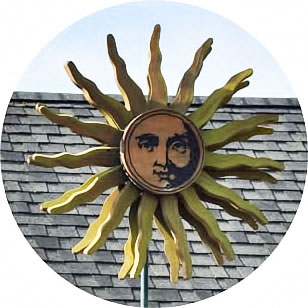
Whirligig above Market Chef Restaurant, Friday Harbor
Contents
July Picnics
Modern Woodcarvers and their Cookie Molds
Mold Maker: Gene Wilson, HOBI Cookie Molds
Tip: Adjusting for Individual Cookie Molds
Mold Maker: Vince Marine
Mold Maker: Dan and Jane Coultis, Cherry Cookie Molds
Mold Maker: Kyna Campbell, My Cookie Mold
Recipe: Maple Orange Cookies
Mold Maker: Jan VandeVoorde
Mold Maker: Walter Geluyckens
Mold Maker: S.R.White Carving
Mold Maker: Digsmed
Mold Maker: Anonymous
They Sneaked In! More Good Picnic Cookie Molds
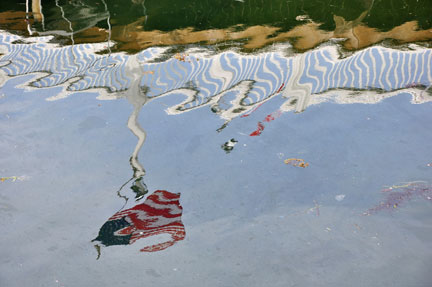
Fourth of July Reflections, Roche Harbor
July Picnics
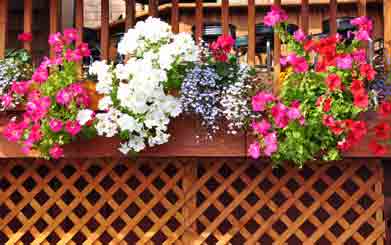
Flowers, downtown Friday Harbor
If San Juan Island is ever going to have hot weather, July is the time. Suddenly, we go from our majority-of-the-year complaining about the cold to either enjoying the heat or griping about it. I'm one of the gripers, I'm afraid. I don't mind heat—since I grew up in New Orleans, summers on the island don't actually seem all that hot. But it's so still here on hot days. The expression that the "wind has died" seems all too literal. The wind seems to be actually dead, as if we'll never feel it again.
Fans hum all day and all night, and opening or closing particular windows becomes a major decision. The ones that open onto the cool spot under the cherry tree? Yes, let's open those. The larger ones at the south-facing deck? Maybe not. Moving from one chair to another requires a major effort.
Still, summer is just glorious. Flowers are everywhere. Swaths of bright blossoms, with a bright blue sea shining in the distance, are a sort of Friday Harbor signature. Sailboats, too—though my love of sailing has been curtailed by knowing how cold the water is, even in July. Aaron and I took a few sailing lessons when we lived in Olympia, and one of the first things the instructor did was to warn us how short a time you can survive in the water of Puget Sound before you die of hypothermia. Since I originally learned to sail in Florida, this got my attention all too well, and I abandoned the idea of northern sailing. Still, the boats are lovely to watch.
The town of Friday Harbor goes all out for the Fourth of July weekend. It's the height of the tourist season, and the streets and shops are jammed. Everyone is having a good time. There's a picnic to celebrate the "Pig War," which is one of the interesting trivia of U.S. History. Here's the story:
In 1856, the border between Canada and the United States was marked off by the Treaty of Oregon. Unfortunately, the treaty had its vague moments, and one major one was where it set the border in the San Juan Islands area as "the middle of the Channel which separates the continent from Vancouver Island." Sounds fine, but there are two channels. Naturally, the British, who governed Canada at that time, interpreted the treaty as giving them the San Juan Islands, while the United States saw it the other way.
In 1859, nationals from both countries lived in the islands. The "war" was started when an American farmer shot a pig belonging to a British citizen. This precipitated a military standoff that lasted until 1872, when the territorial dispute was settled by arbitration. The pig was actually the only casualty, but we still have two parks: "English Camp" and "American Camp" at opposite ends of the island, located where the garrisons were—and still with a few historic buildings left from them. The two sites are now a National Historic Park, the only one in the United States to celebrate the peaceful settlement of a dispute.
The pig's name—if it had one—has not come down to us in the historical account. But even though I could find no handcarved wood cookie mold in the image of a pig, I included a pig mold anyway. It sneaked in—which was what the original pig evidently did, too, sneaked into the farmer's garden in search of something tasty to eat. Although this issue is devoted to modern carvers and their molds, a pig shaped ceramic mold sneaked into it. All things considered, it seems appropriate. The cookies I've discussed are "picnic cookies," which means they're rather small and not too delicate.
Sometimes, I think Aaron and I should picnic in our own front yard. It's a long slope down to the bay, with a view of boats, mountains, and Fourth of July fireworks. I can't think of a better place, but somehow, picnics are meant to be eaten elsewhere, not at home. I'd feel silly with a picnic basket in my own yard. We'll probably pack the basket and go to American Camp instead.
So what kind of cookies should you make for a picnic? It helps if they're not too fragile. So for this month, we'll be going back to honey cookie recipes. There are many of them in my book, Baking with Cookie Molds, as well as the ones in issues of this magazine.
Then, too, a picnic seems a good opportunity for sandwich cookies. You can put in some fancy flavors in the lower layer of the sandwich and the filling. Pack your picnic basket and set off for a beautiful afternoon. Look out for ants!
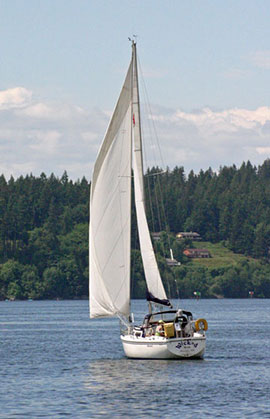
Modern Woodcarvers and their Cookie Molds
In the May issue of this magazine, we looked at antique cookie molds. Most of them were made by carvers who didn't sign their work. Their names are lost today, although their carvings remain. Sometimes I look at an old cookie mold and wonder about the person who made it—and all the people who've used it over the years.
Cookie molds are still being carved, although some of the ones you'll find are unsigned. Other carvers are deservedly well known, and some are masters. There will be no lack of handmade wooden cookie molds from our era to bequeath to the future—a pleasing thought. History is about many things, and only a few—usually unpleasant things like border disputes—make it into the history books. I like to think of a history of fall afternoons, a carver quietly making a plank of cherry into a treasure, a baker turning out fine cookies for a party.
This month we're looking at modern cookie mold carvers. I've included whatever I could find in the way of information about them, including contact information if that was available.
Mold Maker: Gene Wilson, HOBI Cookie Molds
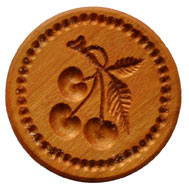
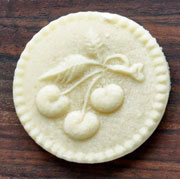
My very first cookie mold was a St. Nicholas carved by Gene Wilson. Maybe that was why I fell in love with cookie molds.
Gene has been carving molds since 1972. According to his web site:
Gene has worked to perfect his technique of power tool engraving with a hand-held router. This innovative, self-taught type of freehand carving has allowed a vast variety of molds to be offered at affordable prices. Since no carving templates are used, each mold is an original carving with it's own 'personality.'
The molds I've bought from Gene have all been cherry, but he also works in beech.
Gene's molds are very detailed, belying the belief that fine carving can't be done with power tools. Asked how long it takes to carve a mold, Gene says, ""It took me twenty years to learn, twenty minutes to carve, twenty minutes to sand, shape, trace—and ten minutes to apply finish... in other words, it takes just a little over twenty years."
He makes molds for springerle, gingerbread, and butter, as well as cookie stamps. Also, one of his springerle designs, the "world's smallest springerle mold" makes a delightful necklace pendant, if you thread it on a ribbon or chain.
Illustrated here are two of Gene's cookie stamps and cookies made from them. Cherries and a sunflower, perfect for summer picnic cookies! And cookie stamps are easy to use, so there's no worry if you're a beginner. Both cookies shown are made with the "Anne's Lemon Cookies" recipe from my book, Baking with Cookie Molds. Good plain, or make them into sandwich cookies with lemon curd, lemon, orange, or coconut buttercream, Nutella, or ricotta cheese.
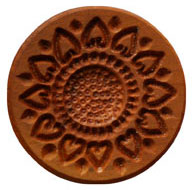
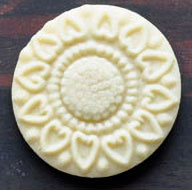
Tip: Adjusting for Individual Cookie Molds
Cookie molds are unique designs, and you may need to prepare one cookie mold differently from another. For example, with the two Gene Wilson cookie stamps pictured above, I've found that I need to oil the sunflower stamp lightly and flour the dough. But for the cherry mold, what works best is to flour both the stamp and the dough. The difference is the textured bit in the center of the sunflower. It just doesn't release well unless it has been oiled.
As you use your cookie molds, you may also find that certain molds work best with particular kinds of dough. Be open to experimenting as you make your cookies. You'll get better results.
Mold Maker: Vince Marine

Photo courtesy House on the Hill
Vince makes custom cookie molds, and has also made molds for House on the Hill. His cherry blossom mold, above, is produced by them, as is the Three Rosettes mold below. (For July picnic cookies, the rosettes could be colored as fireworks.)
Vince lives and works in suburban Chicago where he carves cookie molds in his home studio.
By day he works as a metal engraver, carving reverse images in brass for paper embossing. A few years ago, he saw an article in the newspaper about springerle molds and realized a springerle mold was nothing more than an embossing die for cookie dough. He has been making cookie molds ever since, both for House on the Hill and for private customers.
What makes Vince's molds special is the sculptural quality, depth, and high degree of detail.
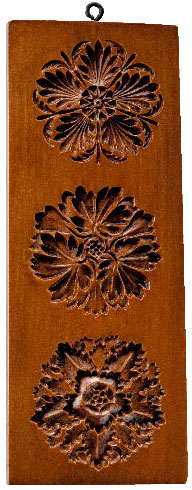
Photo courtesy House on the Hill
Mold Maker: Dan and Jane Coultis, Cherry Cookie Molds
www.cherrycookiemolds.com
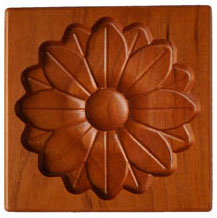
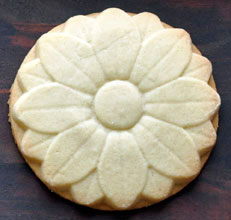
According to the Cherry Cookie Molds web site, Dan and Jane Coultis were inspired to create
. . . molds that are more of an American style . . . something that was new, fresh and would resonate with Americans. We love to visit the ocean and vacation in the Outer Banks of North Carolina, and because of that we came up with a nautical theme consisting of star fish, sand dollars, anchors and sea shells. The first ones were beautiful and, with slight modifications to the molds, they made great cookies. Our next challenge was to create designs for Christmas. Soon we started making the Christmas tree, snowman, bells and the Christ star. The molds were selling by word of mouth and then sales improved when we established this website in 2009 . . . The products are made of hardwood and machined using traditional and advanced woodworking machinery. The wood supplied currently is sourced from the mountains of Eastern Tennessee. The wood is beautiful and machines like a dream.
Shown are a floral mold and a pinwheel cookie stamp. The pinwheel is smaller, and would make a good sandwich cookie.
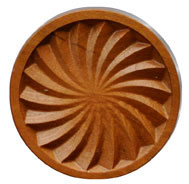
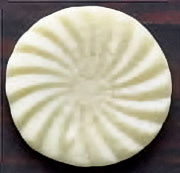
Mold Maker: Kyna Campbell, My Cookie Mold
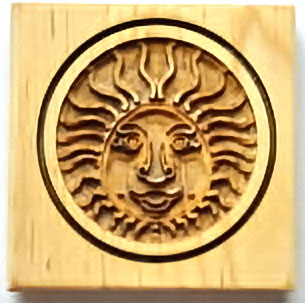
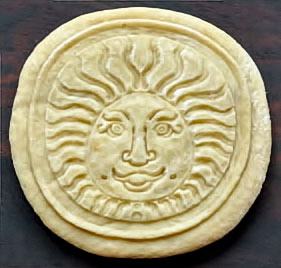
Kyna's molds are laser cut, and highly detailed. This cookie was made with the Maple Orange Cookies recipe given below.
Recipe: Maple Orange Cookies
These make great sandwich cookies with fig preserves as a filling.
>1 cup (225 grams) unsalted butter
1 large egg
1/2 cup (160 milliliters) maple syrup
1 teaspoon natural orange extract
1/2 teaspoon culinary orange oil
1/2 teaspoon maple flavoring extract
1/4 cup (50 grams) sugar
1/4 cup (37 grams) maple sugar
1/2 teaspoon cinnamon
1/4 teaspoon salt
About 4-3/4 cups (665 grams) all-purpose flour
1. Melt the butter and set aside.
2. Beat the egg in a large bowl until yolk and white are fully mixed.
3. Mix the maple syrup, orange extract, orange oil, and lemon flavoring. Add to the egg and beat until well mixed.
4. Mix the sugars, cinnamon, and salt. Add to the egg mixture and beat until well mixed.
5. Add the melted butter slowly and beat until well mixed..
6. Add flour slowly until the dough is solid enough to knead.
7. Knead in additional flour until the dough is the consistency of children's modeling clay.
8. Roll the cookie dough to a uniform thickness. Mold per the instructions for your cookie molds.
9. Bake the cookies at 325°F (163°C) for ten to twelve minutes.
Mold Maker: Jan VandeVoorde
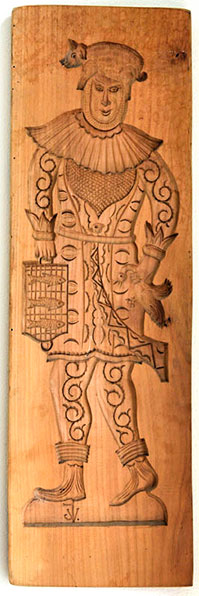
I've never made a cookie with this mold, partly because it's larger than my cookie sheet and larger than my oven.
The mold's unique images did inspire me to write a story, which I published in the January issue of this magazine. I'm sure the plot I came up with was far from what Mr. VandeVoorde had in mind when he carved the mold, but it made sense to me.
If your oven is larger than mine, and if you have a large mold, my December issue has helpful tips for handling large cookies.
Mr. VandeVoorde lives in Belgium, and is regarded as a modern master carver.
Mold Maker: Walter Geluyckens
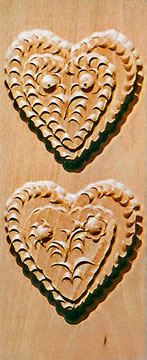
Walter Geluyckens is considered another of the modern masters of cookie mold carving. I don't own one of his molds, so I can't show a cookie, but this photo of one of his beautiful carvings was supplied by a friend.
Mold Maker: S.R. White Carving
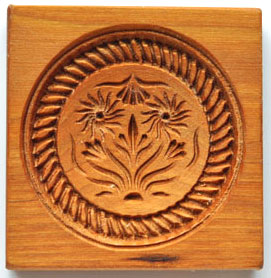

According to their web site,
S.R. White Carving has been producing traditional high quality American wood carvings since 1979. We take pride in the quality and craftsmanship put into every piece we produce here at our studio located in the mountains of Central Pennsylvania.
The mold above is called Double Thistle in the S.R. White catalog. I included it this month because it could also be fireworks—so many plant and floral forms are rather similar to fireworks. Or is it the other way around?
Probably my favorite S.R. White mold, and actually one of my all-time favorites, especially for beginners, is their Large Thistle, shown below. This mold makes a strong, sharp impression and it's very rare for the dough to stick in it.
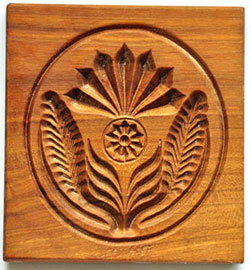
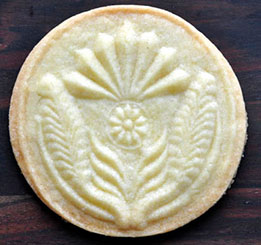
Mold Maker: Digsmed
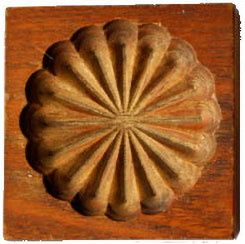
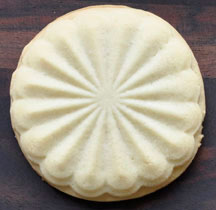
The back of this mold is stamped "Digsmed" and "Danmark." "Danmark," of course is Denmark, but I was unable to find out much about the Digsmed company, other than that they manufactured various wood objects as well as furniture, and are apparently no longer in business. It's a nice shape for a cookie.
Mold Maker: Anonymous
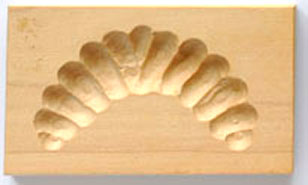
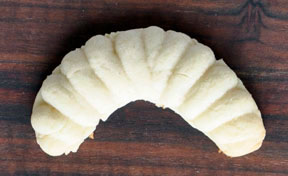
Here's a mold by that immortal and prolific carver, Anonymous. Simple as it is, this mold is quite difficult to use—its shape and depth make the cookie hard to unmold, and the carving isn't very smooth, which adds to the problem. It interested me because it resembles a croissant. But here's a bit of advice—when you're making cookies for an occasion, even a picnic, don't try a mold you've never used before. It took me several tries to get one good cookie from this mold, and that's not going to work unless you have lots of time just for cookies.
They Sneaked In! More Good Picnic Cookie Molds
Brown Bag Cookie Molds
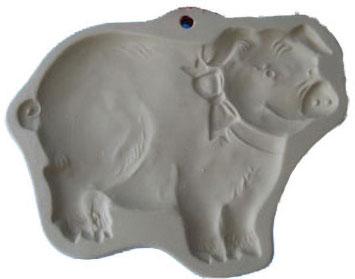
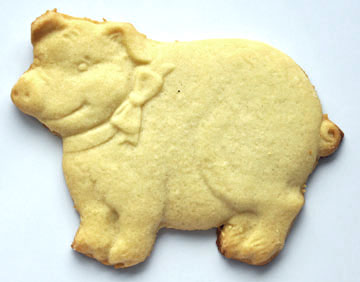
First, the pig! How could a cute guy like this start so much trouble? The mold is from Brown Bag Cookie Molds, no longer manufactured, but not hard to find used.
House on the Hill
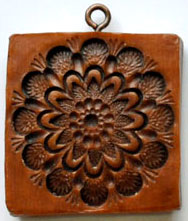
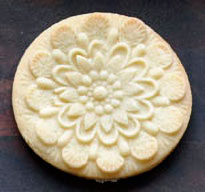
This mold by House on the Hill is perfect for picnic cookies. It's even called Fireworks!


